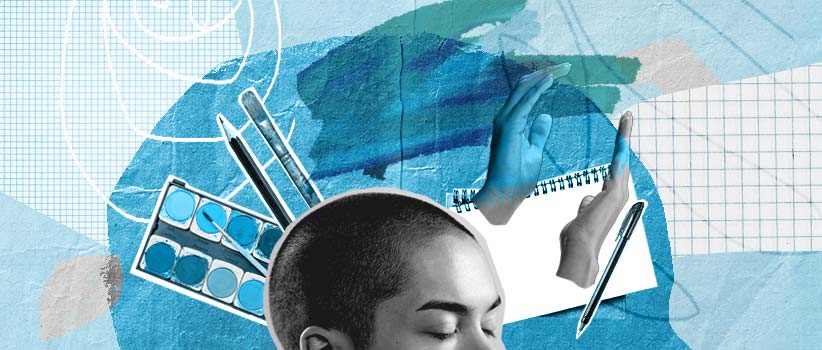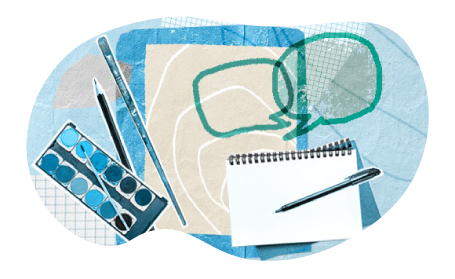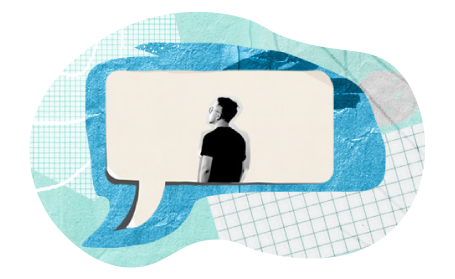How Does Art Therapy Help People Express Their Emotions

Sitting down at the kitchen table with a box of colored pencils to shade in a flower or a bird isn't simply for kids anymore. Adult coloring books have emerged every bit a popular activeness for people trying to reduce their stress and create a sense of calm. In fact, the American Art Therapy Association (AATA) encourages the employ of coloring books for recreation and self-care.
But, while artmaking does have therapeutic benefits, it's important to distinguish information technology from art therapy. Taking artmaking a step further, art therapy emphasizes processing emotions with a credentialed art therapist through the feel of artmaking.
"I view my role every bit walking alongside each client to back up their individual process and witnessing their artwork is part of that procedure," said Lauren Schlenger, an art therapist from Sunstone Counseling in Virginia. "It feels so powerful to be trusted enough to sit with someone while they create and to offer an experience where clients may feel a sense of validation, relief or freedom in the art they make."
Art therapy can be uniquely tailored to fit the specific experiences of each individual. By participating in the journey of art therapy, clients may be able to better empathise themselves in a not-threatening and, sometimes, less invasive way that harnesses their creativity through engaging in emotional processing.
Jump to:
- What Is Fine art Therapy?
- How Does Art Therapy Work?
- Why Art Therapy Works
- Engaging Adolescents in Fine art Therapy
- Art Therapy Resources
What Is Art Therapy?
The AATA defines art therapy as "an integrative mental wellness and human services profession that enriches lives through active art-making, creative process, applied psychological theory, and human experience within a psychotherapeutic relationship."
This grade of therapy is a regulated mental wellness profession facilitated past a credentialed fine art therapist who is specifically trained to utilize art interventions and the creative process to piece of work with individuals on their needs or issues that they seek to accost. While relaxing and soothing, artmaking for self-care lacks the psychological component connected to a treatment plan or set of goals the art therapist is working on with the client.
"When you've created an image or piece of art, you tin can discover pregnant through the artmaking procedure and be improve able to tie that into experiences you lot've had," Schlenger said.
Co-ordinate to Schlenger, key components of art therapy include:
Emotional safety: A trusting therapeutic human relationship tin can assistance foster a safe and not-judgmental space for expressing and processing your concrete feelings.
Emotional validation: Being able to see a visual representation of your feelings and having someone witness your vulnerability in a safe way tin validate your feelings.
Emotional agency:Experiencing the creative process from commencement to finish tin can aid restore a sense of agency and command over your emotions and overall mental health.
"Fine art therapy offers a way for someone to express aspects of themselves without relying on words," said Gretchen Miller, an art therapist in Cleveland and AATA lath member. "It transcends verbal language, and for some people that can exist very not-threatening and prophylactic because they don't have to talk nearly certain experiences or emotions that are very difficult to put into words."
Return to top
How Does Art Therapy Work?
According to Schlenger, an art therapy session may include time for verbal sharing, fourth dimension for more concentrated artmaking to allow clients to become into the flow of their artmaking procedure, and then time to verbally process what the artmaking experience was like and what it meant to them.
"My role isn't to interpret customer artwork just rather to encourage clients to share their personal experience and the meaning they made or discovered when creating," she said. "When processing the artwork, we may besides notice and explore elements of the artwork together to uncover how it connects with their thoughts, feelings and experiences."

Components That Tin Be Included in Art Therapy Sessions
AN INITIAL Bank check-IN TO BUILD RAPPORT
An art therapist may inquire questions like, "What practice you want to talk about in the session?," "What have you been experiencing this week?" and "Exercise you have any goals for art therapy that you want to accomplish?" These questions allow the client to reflect on and understand what emotions are present.
AN OPPORTUNITY FOR PLAY AND EXPLORATION WITH DIFFERENT ART MEDIUMS
Fine art therapy is not constrained to drawing or painting. It tin can include sewing, knitting, cooking, collaging, artistic writing, scrapbooking, digital artmaking, sculpting and photography. Schlenger says having openness is part of the creative process, and clients should engage with different materials that may enable them to improve express themselves through art.
INITIATION OF AN ARTMAKING Activity
According to Schlenger, the fine art therapist can take a directive approach with clients in a session, suggesting a specific art activity, or a non-directive approach, leaving it up to the client to decide what to brand. It depends on whether the client wants structure.
PROCESSING OF EMOTIONS THROUGH MINDFULNESS
Mindfulness is a disquisitional function of art therapy. As clients are creating the fine art, the fine art therapist guides them through self-reflection and encourages cocky-awareness about their feelings. The process allows clients to recognize and identify their feelings, sit with and blot them, and eventually develop new insight based on observing what they felt.
Active Give-and-take WITH THE THERAPIST
A session does not have to exist silent during the artmaking process. The importance lies in processing the emotions and connecting that feel to your art. In fact, Schlenger says that talking through emotions out loud throughout the artmaking process can assist to increase the comfort within the session.
The goal of the session is to reflect on and understand the art that they have made in order to better sympathise and manage feelings moving forrard.
Return to top
Why Art Therapy Works
"It tin can be scary to explore problems near yourself in real life outside the art room, so art therapy offers the opportunity to safely practice things like taking risks through your fine art," Miller said.
The experience of art therapy engages clients in the conclusion-making process, prompting them with questions like what to draw or which colors to apply, which in turn enhances their ability to problem solve and apply that knowledge to real life. It can as well help clients recollect through new possibilities and ways of addressing problems, helping them meet a future beyond the present moment, which may be overcast by negative emotions.
According to a 2020 article on expressive arts therapy inPsychology Today, the practice can help clients dissociate from anxiety, trauma and fear, supporting emotional self-regulation and improve enabling them to respond to stress. Miller teaches her clients specific tools or strategies in the artmaking process that assistance regulate and express emotions past taking what's internal and making it visible.
"It's about taking those emotions building up within someone and being able to put that out there, which in plow empowers clients to explore that more than or exercise something with that emotion in a way that will lead to growth or resolution," Miller said.
According to Schlenger, art therapy is likewise useful in uncovering hidden traumas.
"Sometimes what's expressed in the art tin can bring up unconscious feelings," she said, which clients may need assist working up the courage to talk through. "Information technology's not but the process of creating and talking nearly it but the process of creating past itself."

Questions To Consider Earlier Engaging in Art Therapy
How do you adopt to express your experiences, feelings and thoughts? Miller emphasized that information technology'southward important for people to consider whether information technology's easier to express themselves through images or words.
How do you respond to creating fine art? If you observe yourself experiencing an intense reaction, either negative or positive, during the process of creating art, consider borer into that reaction with an art therapist.
Practise you have a history of pre-verbal trauma?The sensory-based component of art therapy can help you express feelings without words, and so you don't have to rely on speaking and using language if that is too difficult or triggering.
For those who are nervous about seeking fine art therapy handling, creating fine art can withal be a grade of cocky-intendance. Taking a moment for yourself to get out of your caput and engage in something that gives you enjoyment tin help reduce stress and enhance emotional regulation, Miller pointed out.
"Whether your heed is anxiously wandering about the time to come or regretfully ruminating on things in the past yous can't alter, art is there to slow you down," she said. "Information technology helps y'all practice beingness content with and present in the moment, which demonstrates to yous what that feels like and allows you to be able to transfer that to other situations in society to cope.
For those using artmaking as a ways to relax, Miller suggests engaging in rhythmic activities, such as doodling, knitting, crocheting or meditative drawing.
"That repetitive blueprint of doing that over and over again can help calm your thoughts and re-establish a connection with yourself and your own self-care," she said.
Return to top
Engaging Adolescents in Art Therapy
One do good of fine art therapy is that clients do not need to be an creative person to reap the benefits of artmaking in a therapeutic surroundings. This tin can connect well with teens, who are still developing mentally and physically.
"Developmentally, teens are trying to make sense of their ain identity and values," Miller said. "They're thinking well-nigh how they're feeling in their relationships with peers, family and the world."
One benefit of art therapy is that clients exercise not demand to exist an artist to reap the benefits of artmaking in a therapeutic surround.
According to a study on art therapy for adolescents in theWestern Periodical of Medicine, teens and young adults can benefit from art therapy considering it's a not-threatening way to limited their inner thoughts and still receive support. Distressed teens may not trust adults in their lives to help them. In cases of abuse, for case, teens may feel embarrassed to reveal details or fear putting themselves at risk. They can utilise art to limited their emotions and feelings visually.
"When I work with teenage clients, there can be that discomfort of going to therapy, only I endeavour to normalize it and talk about information technology as a healthy way to express yourself," Schlenger said.
From Miller'south experience, art therapy grouping work for teens can be highly benign because they're learning how to chronicle with peers their age. Being in a group with other teens who are besides experiencing like issues tin can help to create a sense of belonging and support while alleviating isolation.
Miller believes that art therapy can assist teens achieve a sense of self-sensation and clarity effectually their strengths, values and beliefs, which amend positions them to understand their struggles and cope.
"Creativity is a huge force of teens at this time, and then they tin can really tap into the art therapy session with that and explore different things happening in their lives," Miller said.
Render to top
Art Therapy Resources
American Fine art Therapy Association: An organization that advocates for attainable art therapy and advances art therapy as a regulated mental health profession.
American Art Therapy Association Fine art Therapist Locator: This is a geographical directory of credentialed art therapists.
Fine art Therapy Credentials Board: Provides boosted information on credentials.
International Expressive Arts Therapy Clan: An arrangement that supports art therapists' work in an inclusive and culturally diverse way.
Art Therapy Without Borders: An organization that promotes art therapy and art therapy inquiry in mental health, educates others on art therapy and develops fine art therapy programs.
The Art Therapy Alliance: An system that uses social media to promote and accelerate fine art therapy and the piece of work of art therapists and seeks to build community.
Remote Fine art Therapy Resources: A listing of fine art therapy resources during coronavirus provided by Children's National Hospital in response to the pandemic.
Art Therapy in Action: Adolescents, AATA: An advisory video on the beneficial relationship that adolescents tin have with fine art therapy.
Thirsty For Fine art: An art therapist who posts resources on art therapy on Instagram and YouTube.
Self-Exercises: These videos dissever self-guided art therapy exercises by low, anxiety, stress direction and emotional pain/healing.
5 Tips for When You Tin can't Draw Your Feelings: A video on how to work around a creative block.
Resources Binder: List of resources such as podcasts, books and groups about fine art therapy and art therapy educational activity.
Return to top
Information on OnlineCounselingPrograms.com is non intended to be a substitute for professional counseling advice. E'er consult qualified professionals with whatsoever questions y'all may have about mental and behavioral wellness-related issues.
Source: https://onlinecounselingprograms.com/resources/art-therapy-young-adults/
ارسال یک نظر for "How Does Art Therapy Help People Express Their Emotions"